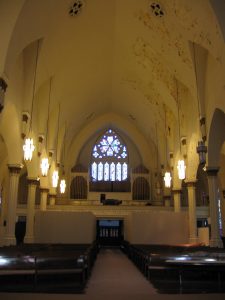 Over the years, our firm has conducted dozens of Property Condition Assessments for religious organizations. Some of these reports – particularly for relatively new buildings – are brief and contain very few surprises for the Owner. Other reports become quite voluminous and, when the numbers are tallied up, there is quite a bit of work to do and the costs can seem overwhelming.
Over the years, our firm has conducted dozens of Property Condition Assessments for religious organizations. Some of these reports – particularly for relatively new buildings – are brief and contain very few surprises for the Owner. Other reports become quite voluminous and, when the numbers are tallied up, there is quite a bit of work to do and the costs can seem overwhelming.
As I have seen it, deferred maintenance starts the day the members move into their brand new church. The length of time over which people will continue to see their church as “brand new” varies greatly. I have worked with churches with a number of buildings, some of which are over a hundred years. They are still calling the addition built in the 1960’s “the new addition”. Just as a car is no longer brand new once you drive it off the lot, a building is not really brand new once you move in. And, just as the longer you keep a car the more money you will have to spend keeping it running, the same is true of buildings. In fact, studies show that over the initial fifty-year span of a new building, the cost of the utilities, maintenance, repairs, improvements, alterations, etc. will cost at least four (4) times as much as the initial construction done in year one. But as long as we see the building as “new”, we are not thinking about (or saving) the money required to properly maintain it. Which is how normal maintenance eventually becomes deferred maintenance.
One solution to this is the concept of Planned Maintenance, where a certain amount of money is set aside each year for future maintenance – starting with the year the building is built. (Ideally, three to five percent of the building replacement value should be set aside each year for repairs and maintenance.) The problems come when those funds (which are typically not needed for the first 5 or more years) are sitting in the bank and the Finance Committee is having trouble balancing the budget. It is very tempting to tap into those funds to preserve a staff position or a much-needed ministry. Unfortunately, repeatedly doing so eventually leads to creating an enormous financial burden for the next generation of building users.
It is not easy to maintain any building, regardless of when or how it was built. The forces of nature are always at work on building materials, none of which will last forever without some kind of maintenance. It is easy, though, to see the list of repairs needed grow exponentially over time if maintenance is not addressed on an as-needed basis. Having a good understanding of what the issues are, how serious they are, what to do next and how much it should cost can help a congregation get a handle on the deferred maintenance and work toward preserving their facilities for future generations. In some cases, if maintenance has been deferred for too long, it can help them see that it is time for some major changes. (For example, a church in Pittsfield, MA recently decided that the best way to preserve their historic worship space was to demolish the poorly maintained Education Wing that would have cost them a fortune to repair.)
There is one other problem with deferred maintenance; i.e., what does it say about you as a church. Churches, like everyone else, only get one chance to make a first impression. There is a good chance that, at some point during their visit, a visitor may need to use a restroom. What kind of message do you think they would get from being greeted with this kind of signage?
If you have signs like these in your church, contact us today about having a Property Conditions Assessment done for your church. It will be the first important step toward preserving for future generations what has been passed on to you by previous generations.


